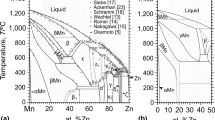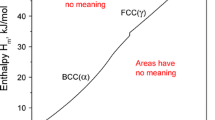Abstract
A theoretical analysis is performed of the topology of the liquidus in the NaBr–Na2CO3–Na2SO4, KBr–K2CO3–K2SO4 systems. The coordinates of minimum point on the monovariant curve in the NaBr–Na2CO3–Na2SO4 system are calculated using the Martynova–Susarev approach. An experimental design is devised for studying systems via differential thermal analysis. The melting point and composition of the salt mixture corresponding to the minimum on the monovariant curve of the NaBr–Na2CO3–Na2SO4 system are determined. The absence of nonvariant equilibrium points in the KBr–K2CO3–K2SO4 system is proved. The NaBr–Na2CO3–Na2SO4, KBr–K2CO3–K2SO4 systems have yet to be studied. They are of interest, since their components have a number of valuable properties, e.g., thermal stability and the possibility of using them as solvents for some other salts over a wide range of temperatures.






Similar content being viewed by others
REFERENCES
Yu. K. Delimarskii and L. P. Barchuk, Applied Chemistry of Ionic Melts (Naukova Dumka, Kiev, 1988) [in Russian].
Yu. K. Delimarskii, Ion Melts in Modern Technology (Metallurgiya, Moscow, 1981) [in Russian].
L. I. Cherneeva, E. K. Rodionova, N. M. Martynova, et al., Reviews on the Thermophysical Properties of Substances (Inst. Vys. Temp. AN SSSR, Moscow, 1980), No. 3, p. 56 [in Russian].
N. A. Vasina, E. S. Gryzlova, and S. G. Shaposhnikova, Thermophysical Properties of Multicomponent Salt Systems (Khimiya, Moscow, 1984) [in Russian].
S. A. Zaretskii, V. N. Suchkov, and P. B. Zhivotinskii, Electrochemical Technology of Inorganic Substances and Chemical Power Sources, The Manual (Vyssh. Shkola, Moscow, 1980), p. 211 [in Russian].
N. V. Korovin, New Chemical Power Sources (Energiya, Moscow, 1978) [in Russian].
N. V. Korovin, Electrochemical Power Engineering (Energoatomizdat, Moscow, 1991) [in Russian].
Chemical Power Sources, The Handbook, Ed. by N. V. Korovin and A. M. Skundin (MEI, Moscow, 2003) [in Russian].
I. K. Garkushin, E. O. Ignat’eva, E. M. Bekhtereva, and V. G. Bamburov, Physico-Chemical Interaction in Systems of Halides, Chromates, Molybdates, and Tungstates of Lithium, Sodium, and Potassium (RIO UrO RAN, Yekaterinburg, 2013) [in Russian].
S. D. Gromakov, On Some Laws of Equilibrium Systems (KGU, Kazan, 1961) [in Russian].
V. M. Vozdvizhenskii, General Patterns in the Structure of Phase Diagrams of Metallic Systems (Nauka, Moscow, 1973), p. 103 [in Russian].
G. I. Zamaldinova, I. K. Garkushin, and S. N. Parfenova, Russ. J. Inorg. Chem. 57, 888 (2012).
A. G. Khachaturyan, Theory of Phase Transformations and the Structure of Solid Solutions (Nauka, Moscow, 1974), p. 328 [in Russian].
A. M. Zakharov, State Diagrams of Binary and Ternary Systems (Metallurgiya, Moscow, 1990) [in Russian].
L. Mindel’korn, Nonstoichiometric Compounds (Khimiya, Moscow, 1971) [in Russian].
E. Yu. Moshchenskaya, Registration State Certificate for Computer Program No. 2006612377 (2006).
V. P. Egunov, Introduction to Thermal Analysis (SamVen, Samara, 1996) [in Russian].
Thermal Constants of Substances, The Reference Book, Ed. by V. P. Glushko (VINITI, Moscow, 1981), No. 10, Part 2 [in Russian].
Salt Fusibility Diagrams, Part 3, Ed. by V. I. Posypaiko and E. A. Alekseeva (Metallurgiya, Moscow, 1977) [in Russian].
N. K. Voskresenskaya, N. N. Evseeva, S. I. Berul’, and I. P. Vereshchetina, Liquid–Solid Equilibria in Anhydrous Inorganic Salt Systems: A Handbook (Akad. Nauk SSSR, Moscow, 1961), Vol. 1 [in Russian].
Salt Fusibility Diagrams. Ternary Systems, Ed. by V. I. Posypaiko and E. A. Alekseeva (Khimiya, Moscow, 1977), p. 328 [in Russian].
ACerS-NIST. Phase Equilibria Diagrams. CD-ROM Database. Version 3.1.0. American Ceramic Society. National Institute of Standards and Technology.
Funding
This work was performed as part of a State Task for Samara State Technical University, 2020 project.
Author information
Authors and Affiliations
Corresponding author
Additional information
Translated by A. Bannov
Rights and permissions
About this article
Cite this article
Syrova, V.I., Garkushin, I.K., Frolov, E.I. et al. Liquidus Topology of NaBr–Na2SO4–Na2CO3 and KBr–K2CO3–K2SO4 Systems. Russ. J. Phys. Chem. 94, 1125–1129 (2020). https://doi.org/10.1134/S0036024420060278
Received:
Revised:
Accepted:
Published:
Issue Date:
DOI: https://doi.org/10.1134/S0036024420060278




